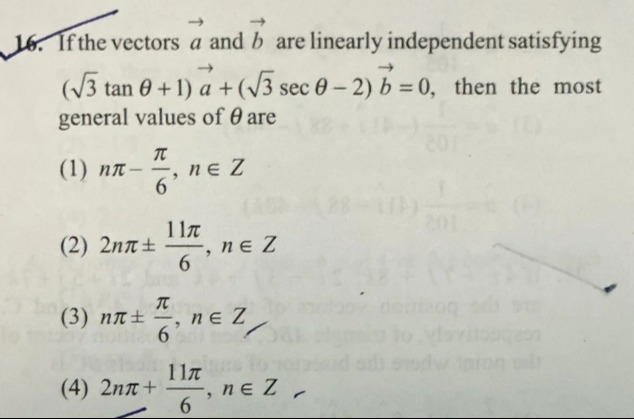Question
Question: If the vectors $\overrightarrow{a}$ and $\overrightarrow{b}$ are linearly independent satisfying $(\...
If the vectors a and b are linearly independent satisfying (3tanθ+1)a+(3secθ−2)b=0, then the most general values of θ are

nπ−6π,n∈Z
2nπ±611π,n∈Z
nπ±6π,n∈Z
2nπ+611π,n∈Z
2nπ+611π,n∈Z
Solution
The given equation is (3tanθ+1)a+(3secθ−2)b=0.
Since the vectors a and b are linearly independent, the coefficients of a and b must both be zero. This gives us two equations:
- 3tanθ+1=0
- 3secθ−2=0
From equation (1):
3tanθ=−1
tanθ=−31
The general solution for tanθ=−31 is θ=nπ−6π, where n∈Z.
From equation (2):
3secθ=2
secθ=32
Since secθ=cosθ1, we have cosθ=23.
The general solution for cosθ=23 is θ=2mπ±6π, where m∈Z.
For θ to satisfy both equations, the values of θ must be common to both general solutions.
The first set of solutions is θ=nπ−6π, n∈Z.
The second set of solutions is θ=2mπ±6π, m∈Z.
Let's check which values from the first set are also in the second set.
Case 1: n is even. Let n=2k for some integer k.
Then θ=2kπ−6π.
This is of the form 2mπ−6π with m=k, which is included in the second set of solutions (2mπ±6π with the negative sign).
Let's verify if this satisfies the condition cosθ=23.
cos(2kπ−6π)=cos(−6π)=cos(6π)=23. This is satisfied.
Let's verify if this satisfies the condition tanθ=−31.
tan(2kπ−6π)=tan(−6π)=−tan(6π)=−31. This is satisfied.
So, θ=2kπ−6π for k∈Z is a valid set of solutions.
Case 2: n is odd. Let n=2k+1 for some integer k.
Then θ=(2k+1)π−6π=2kπ+π−6π=2kπ+65π.
Let's check if this satisfies the condition cosθ=23.
cos(2kπ+65π)=cos(65π)=cos(π−6π)=−cos(6π)=−23.
This is not equal to 23. So, values of θ where n is odd in the first set of solutions are not valid.
Thus, the common solutions are θ=2kπ−6π for k∈Z.
We need to match this form with the given options.
Let's rewrite the solution:
θ=2kπ−6π=2kπ+(2π−6π)−2π=(2k+2)π+(611π−2π)+2π−2π=(2k+2)π−6π.
Alternatively, θ=2kπ−6π=2kπ+611π−2π=(2k−2)π+611π.
Let m=k−1. As k takes all integer values, m also takes all integer values.
So the solution set is θ=2mπ+611π, where m∈Z.
This matches option (4).
Let's check option (4): 2nπ+611π,n∈Z.
θ=2nπ+611π.
tanθ=tan(2nπ+611π)=tan(611π)=tan(2π−6π)=−tan(6π)=−31. This is satisfied.
cosθ=cos(2nπ+611π)=cos(611π)=cos(2π−6π)=cos(6π)=23. This is satisfied.
So, option (4) represents the correct general solution.
